stdClass Object
(
[nazev] => Department of Solid State Chemistry
[adresa_url] =>
[api_hash] =>
[seo_desc] =>
[jazyk] =>
[jednojazycny] =>
[barva] =>
[indexace] => 1
[obrazek] =>
[ga_force] =>
[cookie_force] =>
[secureredirect] =>
[google_verification] =>
[ga_account] =>
[ga_domain] =>
[ga4_account] => G-VKDBFLKL51
[gtm_id] =>
[gt_code] =>
[kontrola_pred] =>
[omezeni] => 0
[pozadi1] =>
[pozadi2] =>
[pozadi3] =>
[pozadi4] =>
[pozadi5] =>
[robots] =>
[htmlheaders] =>
[newurl_domain] => 'uchpel.vscht.cz'
[newurl_jazyk] => 'en'
[newurl_akce] => '[en]'
[newurl_iduzel] =>
[newurl_path] => 8548/22498/22500
[newurl_path_link] => Odkaz na newurlCMS
[iduzel] => 22500
[platne_od] => 31.10.2023 17:11:00
[zmeneno_cas] => 31.10.2023 17:11:41.604819
[zmeneno_uzivatel_jmeno] => Jan Kříž
[canonical_url] =>
[idvazba] => 28125
[cms_time] => 1713915088
[skupina_www] => Array
(
)
[slovnik] => stdClass Object
(
[logo_href] => /
[logo] =>  [logo_mobile_href] => /
[logo_mobile] =>
[logo_mobile_href] => /
[logo_mobile] =>  [google_search] => 001523547858480163194:u-cbn29rzve
[social_fb_odkaz] =>
[social_tw_odkaz] =>
[social_yt_odkaz] =>
[intranet_odkaz] => http://intranet.vscht.cz/
[intranet_text] => Intranet
[mobile_over_nadpis_menu] => Menu
[mobile_over_nadpis_search] => Search
[mobile_over_nadpis_jazyky] => Languages
[mobile_over_nadpis_login] => Login
[menu_home] => Homepage
[aktualizovano] => Updated
[autor] => Author
[paticka_budova_a_nadpis] => BUILDING A
[paticka_budova_a_popis] =>
Rector,
Department of Communications,
Department of Education,
FCT Dean’s Office,
Centre for Information Services
[paticka_budova_b_nadpis] => BUILDING B
[paticka_budova_b_popis] =>
Department of R&D, Dean’s Offices:
FET,
FFBT,
FCE,
Computer Centre,
Department of International Relations,
Bursar
[paticka_budova_c_nadpis] => BUILDING C
[paticka_budova_c_popis] => Crèche Zkumavka,
General Practitioner,
Department of Economics and Management,
Department of Mathematics
[paticka_budova_1_nadpis] => NATIONAL LIBRARY OF TECHNOLOGY
[paticka_budova_1_popis] =>
[paticka_budova_2_nadpis] => CAFÉ CARBON
[paticka_budova_2_popis] =>
[paticka_adresa] => UCT Prague
[google_search] => 001523547858480163194:u-cbn29rzve
[social_fb_odkaz] =>
[social_tw_odkaz] =>
[social_yt_odkaz] =>
[intranet_odkaz] => http://intranet.vscht.cz/
[intranet_text] => Intranet
[mobile_over_nadpis_menu] => Menu
[mobile_over_nadpis_search] => Search
[mobile_over_nadpis_jazyky] => Languages
[mobile_over_nadpis_login] => Login
[menu_home] => Homepage
[aktualizovano] => Updated
[autor] => Author
[paticka_budova_a_nadpis] => BUILDING A
[paticka_budova_a_popis] =>
Rector,
Department of Communications,
Department of Education,
FCT Dean’s Office,
Centre for Information Services
[paticka_budova_b_nadpis] => BUILDING B
[paticka_budova_b_popis] =>
Department of R&D, Dean’s Offices:
FET,
FFBT,
FCE,
Computer Centre,
Department of International Relations,
Bursar
[paticka_budova_c_nadpis] => BUILDING C
[paticka_budova_c_popis] => Crèche Zkumavka,
General Practitioner,
Department of Economics and Management,
Department of Mathematics
[paticka_budova_1_nadpis] => NATIONAL LIBRARY OF TECHNOLOGY
[paticka_budova_1_popis] =>
[paticka_budova_2_nadpis] => CAFÉ CARBON
[paticka_budova_2_popis] =>
[paticka_adresa] => UCT Prague
Technická 5
166 28 Prague 6 – Dejvice
IČO: 60461373 / VAT: CZ60461373
Czech Post certified digital mail code: sp4j9ch
Copyright: UCT Prague 2015
Information provided by the Department of International Relations and the Department of R&D. Technical support by the Computing Centre.
[paticka_odkaz_mail] => mailto:Michal.Simek@vscht.cz
[zobraz_desktop_verzi] => switch to desktop version
[social_fb_title] =>
[social_tw_title] =>
[social_yt_title] =>
[drobecky] => You are here: VŠCHT Praha – FCHT – ÚCHPEL
[more_info] => more information
[zobraz_mobilni_verzi] => switch to mobile version
[paticka_mapa_odkaz] =>
[nepodporovany_prohlizec] => For full access, please use different browser.
[preloader] => Wait a second...
[hledani_nadpis] => hledání
[hledani_nenalezeno] => Nenalezeno...
[hledani_vyhledat_google] => vyhledat pomocí Google
[social_in_odkaz] =>
[social_li_odkaz] =>
)
[poduzel] => stdClass Object
(
[22503] => stdClass Object
(
[obsah] =>
[poduzel] => stdClass Object
(
[22509] => stdClass Object
(
[obsah] =>
[iduzel] => 22509
[canonical_url] => //uchpel.vscht.cz
[skupina_www] => Array
(
)
[url] =>
[sablona] => stdClass Object
(
[class] =>
[html] =>
[css] =>
[js] =>
[autonomni] =>
)
)
[22510] => stdClass Object
(
[obsah] =>
[iduzel] => 22510
[canonical_url] => //uchpel.vscht.cz
[skupina_www] => Array
(
)
[url] =>
[sablona] => stdClass Object
(
[class] =>
[html] =>
[css] =>
[js] =>
[autonomni] =>
)
)
[22511] => stdClass Object
(
[obsah] =>
[iduzel] => 22511
[canonical_url] => //uchpel.vscht.cz
[skupina_www] => Array
(
)
[url] =>
[sablona] => stdClass Object
(
[class] =>
[html] =>
[css] =>
[js] =>
[autonomni] =>
)
)
)
[iduzel] => 22503
[canonical_url] =>
[skupina_www] => Array
(
)
[url] =>
[sablona] => stdClass Object
(
[class] =>
[html] =>
[css] =>
[js] =>
[autonomni] =>
)
)
[22504] => stdClass Object
(
[obsah] =>
[poduzel] => stdClass Object
(
[22517] => stdClass Object
(
[nazev] => Department of Solid State Chemistry
[seo_title] => Department of Solid State Chemistry
[seo_desc] =>
[autor] =>
[autor_email] =>
[obsah] => Department of Solid State Chemistry is focused on materials, methods (X-ray diffraction analysis), and industry applications. A wide choice of Bc., MSc., and Ph.D. programs comprises chemistry and technology of inorganic materials, X-ray diffraction analysis for the pharmaceutical industry, and heavy metal migration in the environment.
The research work of the department deals with two basic topics:
- Application of X-ray diffraction methods in pharmaceutical industry, research, production, and quality check
- Applied mineralogy
History of Department
The staff of the Department follows the tradition of the former Department of Mineralogy. Professor F. X. M. Zippe has established mineralogical collections in 1835, which were later enriched and perfected by Professor A. Ondřej (1887-1956). The mineralogical collections are the well-known treasure of the institute. The X-ray diffraction methods were introduced to our department in 1945 and have remained the prime analytical method of our department.
Cooperation
The Department has an official
cooperation with the company Teva Czech Industries s. r. o. since 1991.

[urlnadstranka] =>
[ogobrazek] =>
[pozadi] =>
[iduzel] => 22517
[canonical_url] =>
[skupina_www] => Array
(
)
[url] => /home
[sablona] => stdClass Object
(
[class] => stranka
[html] =>
[css] =>
[js] =>
[autonomni] => 1
)
)
[22604] => stdClass Object
(
[nazev] => Department
[seo_title] => Department
[seo_desc] =>
[autor] =>
[autor_email] =>
[obsah] => Department of Solid State Chemistry is focused on materials, methodics (X-ray diffraction analysis) and industry applications. A wide choice of Bc., MSc., and Ph.D. programs comprises: chemistry and technology of inorganic materials, X-ray diffraction analysis for pharmaceutical industry and heavy metal migration in the environment.
The research work of the department deals with three topics:
- Application of X-ray diffraction methods in pharmaceutical industry, research, production and quality check
- Applied mineralogy
- Migration of heavy metals in the environment
History of department
Staff of the Department follows the tradition of the former Department of Mineralogy. Professor F. X. M. Zippe has established mineralogical collections in 1835, which were later enriched and perfected by Professor A. Ondřej (1887-1956). The mineralogical collections are the well-known treasure of the institute. The X-ray diffraction methods were introduced to our department in 1945 and have remained the prime analytical method of our department.
[iduzel] => 22604
[canonical_url] => //uchpel.vscht.cz/department
[skupina_www] => Array
(
)
[url] => /department
[sablona] => stdClass Object
(
[class] => stranka
[html] =>
[css] =>
[js] =>
[autonomni] => 1
)
)
[22606] => stdClass Object
(
[nazev] => Study
[seo_title] => Study
[seo_desc] =>
[autor] =>
[autor_email] =>
[obsah] =>
[iduzel] => 22606
[canonical_url] => //uchpel.vscht.cz/study
[skupina_www] => Array
(
)
[url] => /study
[sablona] => stdClass Object
(
[class] => stranka_submenu
[html] =>
[css] =>
[js] =>
[autonomni] => 1
)
)
[22605] => stdClass Object
(
[nazev] => Research
[seo_title] => Research
[seo_desc] =>
[autor] =>
[autor_email] =>
[obsah] => Research at the Institute deals with two thematic areas
- Application of X-ray structural and phase analysis in pharmaceutical research, development, production and control.
- Monitoring of polymorphism of active pharmaceutical substances by X-ray diffraction analysis methods and development of this methodology
- Zeolites
- Transport of heavy metals in the environment
- Double layered hydroxides
[urlnadstranka] =>
[ogobrazek] =>
[pozadi] =>
[iduzel] => 22605
[canonical_url] =>
[skupina_www] => Array
(
)
[url] => /research
[sablona] => stdClass Object
(
[class] => stranka
[html] =>
[css] =>
[js] =>
[autonomni] => 1
)
)
[23154] => stdClass Object
(
[nazev] => Mineralogical collections
[seo_title] => Mineralogical collections
[seo_desc] =>
[autor] =>
[autor_email] =>
[obsah] =>
History of the collections
Mineralogical collections at the Prague Institute of Chemical Technology belong to the oldest and best organized university collections. They are internationally registered in a list of world-known collections in Europe.
The first mineralogical collections was created by professor F. X. M. Zippe for pedagogic purposes of the Technical College in Prague in the year 1835. The basis of this collection has enlarged professor Jan Krejci, whose detailed catalogue of minerals issued in the year 1899 has been preserved till the present days. After the first world war the head of the Mineralogy Department was professor Augustin Ondrej. He made his life goal to finish and shape the mineralogical collections in such form which would well serve also to the next generation as a basis of science and pedagogic work. Purchases, donations, collecting expeditions and numerous exchanges have increased the collection from 2 102 to 23 861 inventory numbers. This was also the last entry of professor Ondrej, who passed away on 22 nd July 1956. His successor professor Jan Kaspar visited his life-time perhaps all continents of the world, studying minerals and their deposites. He collected minerals in all countries he visited.
Organization of collections
In the present form the mineralogical collections cover several units. In the first place is the systematic collection which is located in the main large collection hall. In an adjacent smaller room there is the collection of decorative and gem stones. Supplementary collections are located in the corridor in front of the main hall. They include crystalographical, terminological and petrographical collections and further the collections of industrial and technical raw materials. In the so called small collection hall geaochemical and genetic collectioons of minerals are installed. Here are also exhibited collections of meteorites and tektites.
Visiting of the collections
You can visit our mineralogical collections as follows:
Monday - Thursday: 9:00 - 16:00
Friday: 9:00 - 14:00
You must arrange the visit by e-mail or by phone with the secretary (+420-220443798) or with head of department (+420-220444086).
Photos:
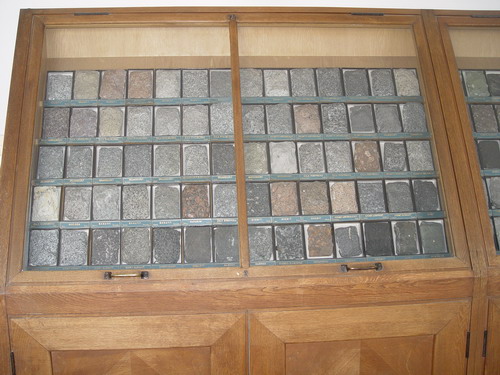 |
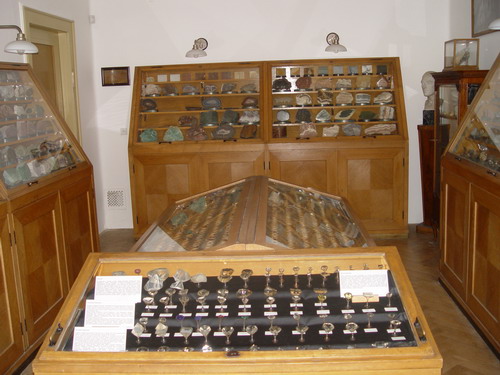 |
| Decoration and precious stones coll. |
Glass models of diamonds |
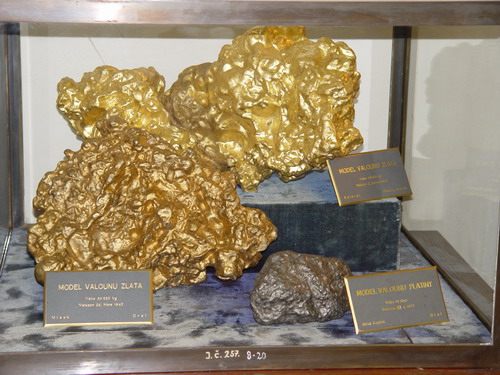 |
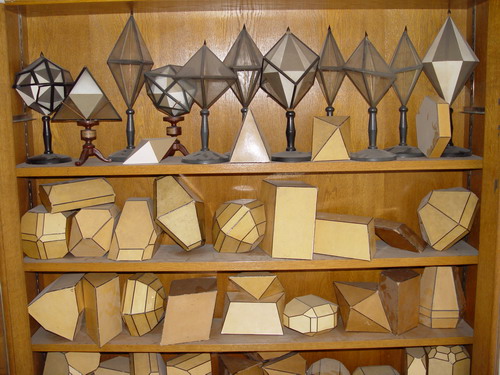 |
| Model of gold and platinum nuggets |
Models of crystal types |
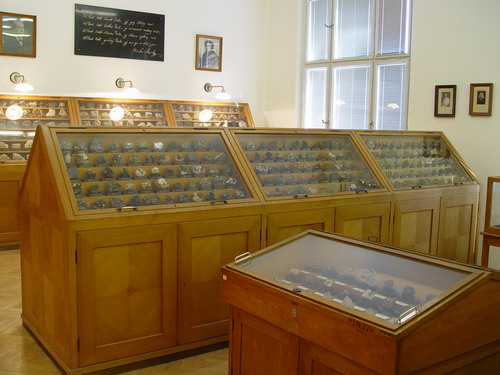 |
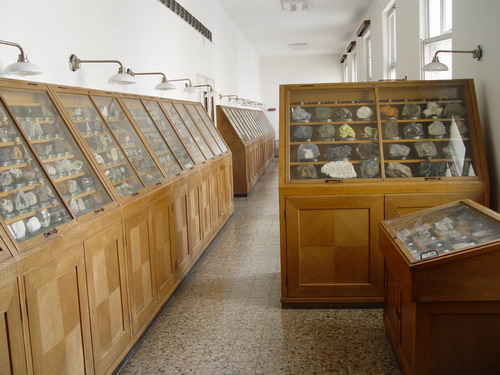 |
| Petrographic collection |
Corridor in front of main hall |
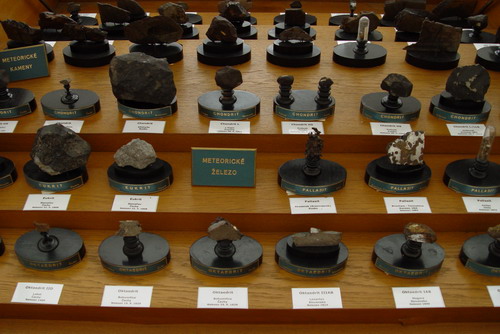 |
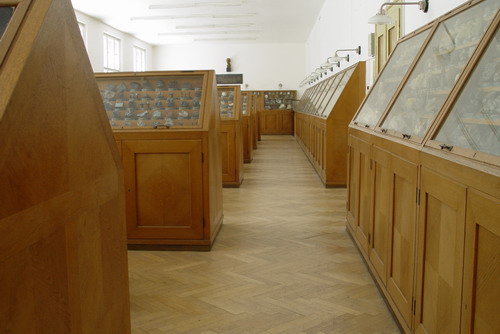 |
| Meteorite collection |
Main collection hall |
[iduzel] => 23154
[canonical_url] => //uchpel.vscht.cz/collections
[skupina_www] => Array
(
)
[url] => /collections
[sablona] => stdClass Object
(
[class] => stranka_galerie_velka
[html] =>
[css] =>
[js] =>
[autonomni] => 1
)
)
[24134] => stdClass Object
(
[obsah] =>
[iduzel] => 24134
[canonical_url] =>
[skupina_www] => Array
(
)
[url] =>
[sablona] => stdClass Object
(
[class] =>
[html] =>
[css] =>
[js] =>
[autonomni] =>
)
)
)
[iduzel] => 22504
[canonical_url] =>
[skupina_www] => Array
(
)
[url] =>
[sablona] => stdClass Object
(
[class] =>
[html] =>
[css] =>
[js] =>
[autonomni] =>
)
)
)
[sablona] => stdClass Object
(
[class] => web
[html] =>
[css] =>
[js] =>
[autonomni] => 1
)
[api_suffix] =>
)
DATA
stdClass Object
(
[nazev] => Applied mineralogy
[seo_title] => Applied mineralogy
[seo_desc] =>
[autor] =>
[autor_email] =>
[obsah] => Selected publications Projects and grants
Team differentiation:
Migration of heavy metals in the environment
doc. Ing. Barbora Doušová, CSc.
Ing. Eva Bedrnová (PGS)
Mgr. Eliška Duchková (PGS) - kombinované
Zeolites
Ing. David Koloušek, CSc.
Layered double hydroxides and mixed oxides
prof. Ing. František Kovanda, CSc.
Ing. Michaela Dvořáková, Ph.D.
Szabolcs Muráth, Ph.D.
Migration of heavy metals in the environment
Due to their structure and sorption properties, some inorganic materials are used to remove toxic substances that are undesirable in the environment. Such materials are clay minerals, iron oxides and hydroxides or zeolites, but also biosorbents, eg biochar.
What toxic substances are we investigating?
Especially arsenic, antimony and selenium, their geochemical properties, stability in waters and soils, transport through the environment.

Symptoms of arsenicosis
What materials do we use to decontaminate affected areas?
To decontaminate stressed areas, we use natural materials based on oxides of iron, aluminum and manganese, but especially aluminosilicates (clay minerals) in their original and modified form. Such materials are tested as selective sorbents suitable for removing toxic substances from soils and waters. We are also newly investigating biological sorbents (biochar), which promise perspective, cheap and ecological solutions in environmental protection.
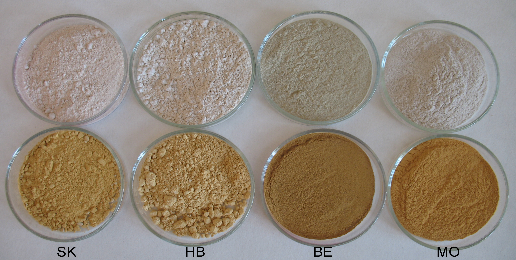
Original and modified clay sorbents
Mechanism of Fe bonding to the surface of the clay matrix
The second research area is focused on finding the optimal conditions for decontamination of a specific loaded system and designing the appropriate remediation technology.
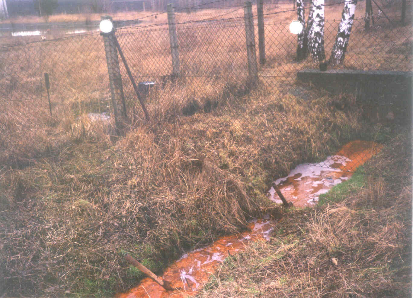 Leaks of acid mine waters in the Kutná Hora district (high concentrations of arsenic and iron)
Leaks of acid mine waters in the Kutná Hora district (high concentrations of arsenic and iron)
How do we measure the concentrations of arsenic, antimony and selenium?
Concentrations of arsenic, antimony and selenium are measured by Atomic Fluorescence Spectrometry with Hydride Generation (HG-AFS) on a PSA 10.055 Millennium Excalibur instrument (manufactured by PSAnalytical, Kent, UK), which allows the determination of trace concentrations of these hydride-forming elements within the detection limit.
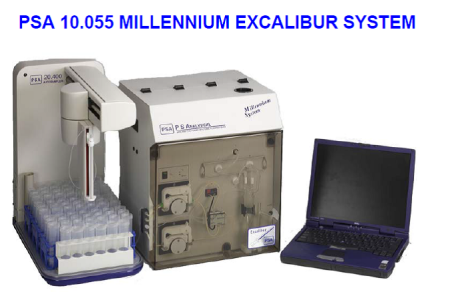
Semi-quantitative analysis of solid samples is performed by X-ray fluorescence spectroscopy (XRF) on a Rigaku NEX QC energy dispersive spectrometer (manufactured by Applied Rigaku Technologies, Inc., Austin, TX, USA) which allows the determination of elements from sodium (11Na) to uranium (92U) in solid substances, liquids, powders and alloys.
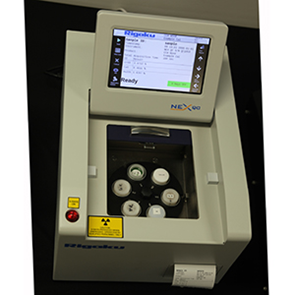
Zeolites
Zeolites are crystalline hydrated aluminosilicates of alkaline metals alkaline earth metals. The basic of zeolite structure is anionic frame of Si and Al T-atoms, which are tetrahedral coordinated with oxygen atoms. By reason of electrostatic forces it is not possible to make an Al-O-Al bond. Tetrahedrons form single or multipath circles, thereby cavities with diferent size originate in zeolite structure. These cavities are connected by channels. Non-frames cations are not fixed closely and can be changed for another cations. Zeolites are often used in ion-exchange reactions, have unique properties as sorbents and molecular sieves, and play important role in heterogenous catalysis. Zeolites offer in natural localities and a number of it was prepared synthetically.

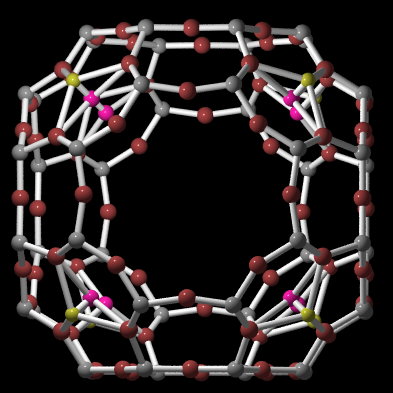
Structure of zeolites
In the Department of Solid State Chemistry, a synthesis technology was developed based on the hydrothermal reaction of fly-ashes (from power plants) and certified many use-possibilities of these zeolites (heavy metal cations separation, radioactive isotopes separation from wastewater, use in agriculture, etc.).
What do we study about zeolites?
- preparation of so-called geopolymer zeolites (zeolites A, X and P) from brick tablecloths
- separation of water from the water-ethanol system (preparation of absolute alcohol)
- influencing the sensory properties of wine by natural and synthetic zeolites
- recirculation systems for fish farming.
Layered double hydroxides and mixed oxides
Layered double hydroxides (LDHs), known also as hydrotalcite-like compounds or anionic clays, represent a group of important inorganic materials usable in many applications. Their chemical composition can be expressed by the general formula MII1-xMIIIx(OH)2An-x/n·yH2O where MII and MIII are divalent and trivalent metal cations and An- is an n-valent anion. These compounds have a layered crystal structure composed of positively charged hydroxide layers [MII1-xMIIIx(OH)2]x+ and interlayers containing anions and water molecules. The value of x, usually in the range from 0.20 to 0.33, represents a portion of trivalent metal cations substituted in hydroxide layers. Layered double hydroxides exhibit anion-exchange properties; a weak bonding between the hydroxide sheets and interlayer anions enables their exchange for the other ones. At moderate temperatures (up to about 500 °C) layered double hydroxides are decomposed to form mixed oxides of MII and MIII metals. These mixed oxides are rehydrated in aqueous solutions; the rehydration process results in reconstruction of the layered LDH structure and intercalation of anions from the solution into interlayers. This unique property of layered double hydroxides can be employed for preparation of compounds intercalated with various anions and polar molecules or in removal of undesirable components from solutions. The delamination/restacking procedure, when LDHs are restacked from colloidal dispersion formed by their delamination in a suitable solvent, represents an interesting way for intercalation of water-insoluble components. The often used group name “hydrotalcite-like compounds” is related to the mineral hydrotalcite (Mg6Al2(OH)16CO3·4H2O). A group of other natural minerals with analogous crystal structure has been reported and a great number of synthetic compounds, combining various MII and MIII metal cations in hydroxide layers and various anions intercalated in the interlayers, can be prepared.

Structure of layered double hydroxides
Synthetic hydrotalcite is used mainly in the plastics industry, namely as a component of PVC stabilizing compositions and as a neutralizing agent (acid scavenger) in production of polyolefins. Layered double hydroxides can be applied also as nanofillers for synthesizing polymer-based nanocomposites, in which inorganic nanoparticles dispersed in relatively low concentration in the polymer matrix improve its properties. The representative pharmaceutical application of layered double hydroxides is the hydrotalcite-derived antacid. They are also studied as carriers for drugs and other bioactive substances. Layered double hydroxides are widely used in heterogeneous catalysis, mainly as precursors for preparation of mixed oxide-based catalysts. The anion-exchange properties of layered double hydroxides and their ability to recover the layered crystal structure during rehydration of thermally decomposed products may be utilized for adsorption of undesirable contaminants. Layered double hydroxides are often used also as host inorganic structure suitable for intercalation of various anions and molecules, resulting in the preparation of hybrid materials with interesting physical and chemical properties.
Our interests
Preparation of precursors and mixed oxides for heterogeneous catalysis
Our research is focused on preparation of layered double hydroxides and other precursors of desired chemical composition and thermal treatment of these precursors including a study of the thermal decomposition, formation of oxide phases and their transformation during heating. We are interested also in the deposition of precursors and mixed oxides on metal and ceramic supports. The obtained materials are then studied as catalysts for removal of gaseous pollutants, namely the volatile organic compounds and.
Preparation of layered double hydroxides intercalated with organic components
We are concerned with synthesis of the host structures and their intercalation with organic anions or molecules, especially the active pharmaceutical ingredients; this research is focused on development of new solid dosage forms. The layered double hydroxides intercalated with organic components are studied also in other applications such as preparation of LDH/polymer nanocomposites and photoactive materials. We are interested also in synthesis of other organic-inorganic hybrid materials.
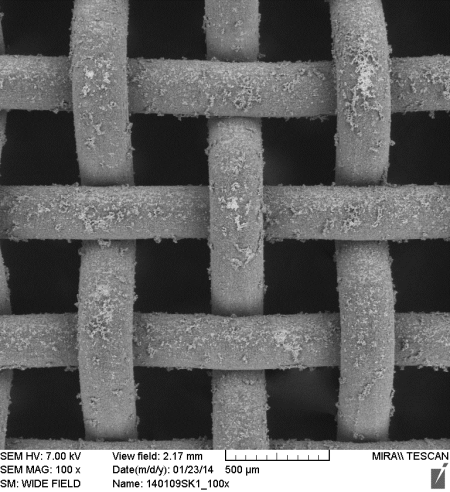
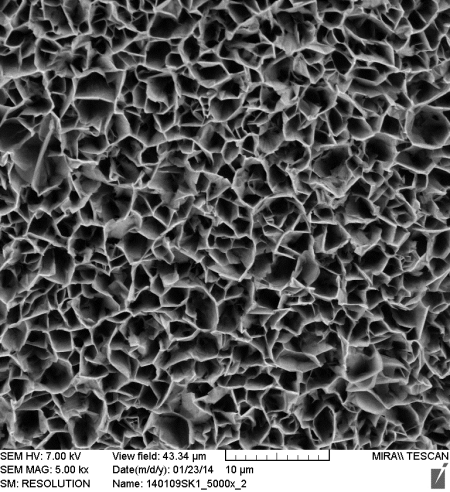
Supported catalyst with active layer of Co-Mn-Al mixed oxide obtained by thermal decomposition of LDH precursor prepared on anodized aluminum mesh
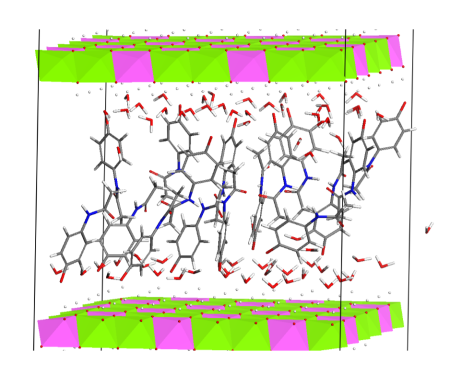
Arrangement of paracetamol molecules intercalated in the LDH interlayer
[submenuno] =>
[urlnadstranka] =>
[ogobrazek] =>
[pozadi] =>
[newurl_domain] => 'uchpel.vscht.cz'
[newurl_jazyk] => 'en'
[newurl_akce] => '/research/research_groups/applied_mineralogy'
[newurl_iduzel] => 23143
[newurl_path] => 8548/22498/22500/22504/22605/22616/23143
[newurl_path_link] => Odkaz na newurlCMS
[iduzel] => 23143
[platne_od] => 15.04.2021 00:02:00
[zmeneno_cas] => 15.04.2021 00:06:46.226399
[zmeneno_uzivatel_jmeno] => Jan Rohlíček
[canonical_url] =>
[idvazba] => 28925
[cms_time] => 1713915088
[skupina_www] => Array
(
)
[slovnik] => Array
(
)
[poduzel] => stdClass Object
(
[23145] => stdClass Object
(
[nazev] => Projects
[seo_title] => Projects
[seo_desc] =>
[autor] =>
[autor_email] =>
[obsah] => Innovative plasma-chemical and chemical synthesis of nickel-containing mixed oxide catalysts for the oxidation of volatile organic pollutants (2021 – 2023) (project No. 21-04477S, Czech Science Foundation)
Bioaccesibility and environmental interaction of antimony near busy traffic nodes (2019 – 2021) (project No. 19-04682S, Czech Science Foundation)
Concrete slurry - hazardous waste or secondary raw material? (2019 – 2021) (project No. 19-11027S, Czech Science Foundation)
Advanced preparation of catalytically active oxides on metal supports using combination of plasma sputtering and chemical methods (2017 – 2019) (project No. 17-08389S, Czech Science Foundation)
Structured catalysts with active oxide layer for abatement of gaseous pollutants (2014 – 2016)
(project no. 14-13750S, Czech Science Foundation)
Abatement of N2O emissions from waste gas of nitric acid production (2011 – 2013)
(Project no. TA01020336, Technology Agency of the Czech Republic)
Photoactive hybrid materials (2010 – 2013)
(grant project No. 207/10/1447, Czech Science Foundation)
Structured catalysts with low concentration of active components for total oxidation of VOC (2010 – 2012)
(grant project No. 106/10/1762, Czech Science Foundation)
Supported oxidic catalysts containing low amount of active species as catalysts for N2O decomposition (2009 – 2011)
(grant project No. 106/09/1664, Czech Science Foundation)
[urlnadstranka] =>
[ogobrazek] =>
[pozadi] =>
[poduzel] => Array
(
)
[iduzel] => 23145
[canonical_url] =>
[skupina_www] => Array
(
)
[url] => /research/research_groups/applied_mineralogy/projects
[sablona] => stdClass Object
(
[class] => stranka
[html] =>
[css] =>
[js] =>
[autonomni] => 1
)
)
[23144] => stdClass Object
(
[nazev] => List of selected papers
[seo_title] => List of selected papers
[seo_desc] =>
[autor] =>
[autor_email] =>
[obsah] => Topka P., Dvořáková M., Kšírová P., Perekrestov R., Čada M., Balabánová J., Koštejn M., Jirátová K., Kovanda F.: Structured cobalt oxide catalysts for VOC abatement: the effect of preparation method.Environ. Sci. Pollut. Res. 27 (2020) 7608–7617
Jirátová K., Perekrestov R., Dvořáková M., Balabánová J., Topka P., Koštejn M., Olejníček J., Čada M., Hubička Z., Kovanda F.: Cobalt oxide catalysts in the form of thin films prepared by magnetron sputtering on stainless-steel meshes: Performance in ethanol oxidation. Catalysts 806(9) (2019), 16 pp.
Dvořáková M., Perekrestov R., Kšírová P., Balabanová J., Jirátová K., Maixner J., Topka P., Rathouský J., Koštejn M., Čada M., Hubička Z., Kovanda F.: Preparation of cobalt oxide catalysts on stainless steel wire mesh by combination of magnetron sputtering and electrochemical deposition. Catal. Today 334 (2019) 13-23.
Jirátová K., Kovanda F., Balabánová J., Kšírová P.: Aluminum wire meshes coated with Co-Mn-Al and Co oxides as catalysts for deep ethanol oxidation. Catal. Today 304 (2018) 165-171.
Hynek J., Jurík S., Koncošová M., Zelenka J., Křížová I., Ruml T., Kirakci K., Jakubec I., Kovanda F., Lang K., Demel J.: The nanoscaled metal-organic framework ICR-2 as a carrier of porphyrins for photodynamic therapy. Beilstein J. Nanotechnol. 9 (2018) 2960-2967.
Klegová A., Pacultová K., Fridrichová D., Volodarskaja A, Kovanda F., Jirátová K.: Cobalt oxide catalysts on commercial supports for N2O decomposition. Chem. Eng. Technol. 40 (2017) 981-990.
Jirátová K., Balabánová J., Kovanda F., Klegová A., Obalová L., Fajgar R.: Cobalt oxides supported over ceria-zirconia coated cordierite monoliths as catalysts for deep oxidation of ethanol and N2O decomposition. Catal. Lett. 147 (2017) 1379-1391.
Jirátová K., Kovanda F., Balabánová J, Koloušek D., Klegová A., Pacultová K., Obalová L.: Cobalt oxide catalysts supported on CeO2-TiO2 for ethanol oxidation and N2O decomposition. React. Kinet. Mech. Catal. 121 (2017) 121-139.
Basag S., Kovanda F., Piwowarska Z., Kowalczyk A., Pamin K., Chmielarz L.: Hydrotalcite-derived Co-containing mixed metal oxide catalysts for methanol incineration. Role of cobalt content, Mg/Al ratio and calcination temperature. J. Therm. Anal. Calorim. 129 (2017) 1301-1317.
Jirátová K., Kovanda F., Ludvíková J., Balabánová J., Klempa J.: Total oxidation of ethanol over layered double hydroxide-related mixed oxide catalysts: Effect of cation composition. Catal. Today 277 (2016) 61-67.
Pacultová K., Karásková K., Kovanda F., Jirátová K., Šrámek J., Kustrowski P., Kotarba A., Chromčáková Z., Kočí K., Obalová L.: K-doped Co-Mn-Al mixed oxide catalyst for N2O abatement from nitric acid plant waste gases: Pilot plant studies. Ind. Eng. Chem. Res. 55 (2016) 7076-7084.
Ludvíková J., Jablonska M., Jirátová K., Chmielarz L., Balabánová J., Kovanda F., Obalová L.: Co-Mn-Al mixed oxides as catalysts for ammonia oxidation to N2O. Res. Chem. Intermed. 42 (2016) 2669-2690.
Chromčáková Ž., Obalová L., Kustrowski P., Drozdek M., Karásková K., Jirátová K., Kovanda F.: Optimization of Cs content in Co–Mn–Al mixed oxide as catalyst for N2O decomposition. Res. Chem. Intermed. 41 (2015) 9319-9332.
Chromčáková Ž., Obalová L., Kovanda F., Legut D., Titov A., Ritz M., Fridrichová D., Michalik S., Kuśtrowski P., Jirátová K.: Effect of precursor synthesis on catalytic activity of Co3O4 in N2O decomposition. Catal. Today 257 (2015) 18-25.
Klyushina A., Pacultová K., Krejčová S., Słowik G., Jirátová K., Kovanda F., Ryczkowski J., Obalová L.: Advantages of stainless steel sieves as support for catalytic N2O decomposition over K-doped Co3O4, Catal. Today 257 (2015) 2-10.
Lennerová D., Kovanda F., Brožek J.: Preparation of Mg–Al layered double hydroxide/polyamide 6 nanocomposites using Mg–Al–taurate LDH as nanofiller. Appl. Clay Sci. 114 (2015) 265-272.
Jablonska M., Chmielarz L., Wegrzyn A., Guzik K., Piwowarska Z., Witkowski S., Walton R.I., Dunne P.V., Kovanda F.: Thermal transformations of Cu–Mg (Zn)–Al(Fe) hydrotalcite-like materials into metal oxide systems and their catalytic activity in selective oxidation of ammonia to dinitrogen. J, Therm. Anal. Calorim. 114 (2013) 731-747.
Kovanda F., Jirátová K., Ludvíková J., Rabbová H.: Co-Mn-Al mixed oxides on anodized aluminum supports and their use as catalysts in the total oxidation of ethanol. Appl. Catal. A 464 (2013) 181-190.
Ludvíková J., Jirátová K., Kovanda F.: Mixed oxides of transition metals as catalysts for total ethanol oxidation. Chem. Pap. 66 (2012) 589-597.
Kovanda F., Maryskova Z. Kovar P.: Intercalation of paracetamol into the hydrotalcite-like host. J Solid State Chem 184 (2011), 3329-3335.
Kovanda F., Jiratova K.: Supported mixed oxide catalysts for the total oxidation of volatile organic compounds. Catal Today 176 (2011), 110-115.
Kovanda F., Jiratova K.: Supported layered double hydroxide-related mixed oxides and their application in the total oxidation of volatile organic compounds. Appl Clay Sci 53 (2011), 305-316.
Kovar P., Popisil M., Kafunkova E., Lang K., Kovanda F.: Mg-Al layered double hydroxide intercalated with porphyrin anions: molecular simulations and experiments. J Mol Model 16 (2010), 223-233.
Kovanda F., Jindova E., Lang K., Kubat P., Sedlakova Z.: Preparation of layered double hydroxides intercalated with organic anions and their application in LDH/poly(butyl methacrylate) nanocomposites.Appl Clay Sci 48 (2010), 260-270.
Karaskova K., Obalova L., Jiratova K., Kovanda F.: Effect of promoters in Co-Mn-Al mixed oxide catalyst on N2O decomposition. Chem Eng J 160 (2010), 480-487.
Kovanda F., Mašátová P., Novotná P., Jirátová K.: The formation of layered double hydroxides on alumina surface in aqueous solutions containing divalent metal cations. Clay Clay Miner 57 (2009), 425-432.
Obalová L., Karásková K., Jirátová K., Kovanda F.: Effect of potassium in calcined Co-Mn-Al layered double hydroxide on the catalytic decomposition of N2O. Appl Catal B 90 (2009), 132-140.
Jirátová K., Mikulová J., Klempa J., Grygar T., Bastl Z., Kovanda F.: Modification of Co-Mn-Al mixed oxide with potassium and its effect on deep oxidation of VOC. Appl Catal A 361 (2009), 106-116.
Kovanda F., Rojka T., Bezdička P., Jirátová K., Obalová L., Pacultová K., Bastl Z., Grygar T.: Effect of hydrothermal treatment on properties of Ni-Al layered double hydroxides and related mixed oxides. J Solid State Chem 182 (2009), 27-36.
Červený J., Šplíchalová J., Kačer P., Kovanda F., Kuzma M., Červený L.: Molecular shape selectivity of hydrotalcite in mixed aldol condensations of aldehydes and ketones. J Mol Catal A 285 (2008), 150-154.
Kovanda F., Káfuňková E., Rojka T., Lang K.: Intercalation of porphyrins into Mg-Al hydrotalcite. Mater Struct 15 (2008), 28-32.
Lang K., Bezdička P., Bourdelande J. L., Hernando J., Jirka I., Káfuňková E., Kovanda F., Kubát P., Mosinger J., Wagnerová D. M.: Layered double hydroxides with intercalated porphyrins as photofunctional materials: Subtle structural changes modify singlet oxygen production. Chem Mater 19 (2007), 3822-3829.
Obalová L., Jirátová K., Kovanda F., Valášková M., Balabánová J., Pacultová K.: Structure–activity relationship in the N2O decomposition over Ni-(Mg)-Al and Ni-(Mg)-Mn mixed oxides prepared from hydrotalcite-like precursors. J Mol Catal A 248 (2006), 210-219.
Kovanda F., Rojka T., Dobešová J., Machovič V., Bezdička P., Obalová L., Jirátová K., Grygar T.: Mixed oxides obtained from Co and Mn containing layered double hydroxides: Preparation, characterization, and catalytic properties. J Solid State Chem 179 (2006), 812-823.
Obalová L., Jirátová K., Kovanda F., Pacultová K., Lacný Z., Mikulová Z.: Catalytic decomposition of nitrous oxide over catalysts prepared from Co/Mg-Mn/Al hydrotalcite-like compounds. Appl Catal B 60(2005), 289-297.
Kovanda F., Grygar T., Dorničák V., Rojka T., Bezdička P., Jirátová K.: Thermal behaviour of Cu-Mg-Mn and Ni-Mg-Mn layered double hydroxides and characterization of formed oxides. Appl Clay Sci 28 (2005), 121-136.
Kovanda F., Koloušek D., Cílová Z., Hulínský V.: Crystallization of synthetic hydrotalcite under hydrothermal conditions. Appl Clay Sci 28 (2005), 101-109.
Kovanda F., Grygar T., Dorničák V.: Thermal behaviour of Ni-Mn layered double hydroxide and characterization of formed oxides. Solid State Sci 5 (2003), 1019-1026.
Kovanda F., Balek V., Dorničák V., Martinec P., Mašláň M., Bílková L., Koloušek D., Bountseva I.M.: Thermal behaviour of synthetic pyroaurite-like anionic clay. J Therm Anal Calorim 71 (2003), 727-737.
Kovanda F., Jirátová K., Rymeš J., Koloušek D.: Characterization of activated Cu/Mg/Al hydrotalcites and their catalytic activity in toluene combustion. Appl Clay Sci 18 (2001), 71-80.
Kovanda F., Koloušek D., Kalousková R., Vymazal Z.: Zahájení výroby syntetického hydrotalcitu v České republice. Chem Listy 95 (2001), 493-497.
Dousova B., Lhotka M., Grygar T., Machovic V., Herzogova L.: In situ co-adsorption of arsenic and iron/manganese ions on raw clays. Appl Clay Sci 54 (2011), 166-171.
Dousova B., Fuitova L., Herzogova L. et al.: Modified low-grade aluminosilicates as effective sorbents of hazardeous oxyanions from aqueous systems. Acta Geodyn Geomater 6 (2009), 193-200.
Dousova B., Fuitova L., Grygar T. et al.: Modified aluminosilicates as low-cost sorbents of As(III) from anoxic groundwater. J Hazard Mater 165 (2009), 134-140.
Erbanova L., Novak M., Fottova D., Dousova B.: Export of arsenic from forested catchments under easing atmospheric pollution. Environ Sci Technol 42 (2008), 7187-7192.
Dousova B., Martaus A., Fillipi M. et al.: Stability of arsenic species in soils contaminated naturally and in an anthropogenic manner. Water Air Soil Poll 187 (2008), 233-241.
Dousova B., Erbanova L., Novak M.: Arsenic in atmospheric deposition at the Czech-Polish border: Two sampling campaigns 20 years apart. Sci Total Environ 387 (2007), 185-193.
Grygar T., Hradil D., Bezdicka P., Dousova B., Capek L., Schneeweiss O.: Fe(III)-modified montmorillonite and bentonite: Synthesis, chemical and UV-vis spectral characterization, arsenic sorption, and catalysis of oxidative dehydrogenation of propane. Clay Clay Miner 55 (2007), 165-176.
Filippi M., Dousova B., Machovic V.: Mineralogical speciation of arsenic in soils above the Mokrsko-west gold deposit, Czech Republic. Geoderma 139 (2007), 154-170.
Dousova B., Grygar T., Martaus A. et al.: Sorption of As-V on alumino silicates treated with Fe-II nanoparticles. J Colloid Inter Sci 302 (2006), 424-431.
Dousova B., Kolousek D., Kovanda F. et al.: Removal of As(V) species from extremly contaminated mining water. Appl Clay Sci 28 (2005), 31-42.
Dousova B., Machovic V., Kolousek D., Kovanda F., Dornicak V.: Sorption of As(V) species from aqueous systems. Water Air Soil Poll 149 (2003), 251-267.
Dousova B., Kolousek D., Kovanda F. Způsob dvoustupňové dekontaminace důlní vody s vysokým obsahem arsenu a iontů železa. PV 2003-3445, 2003.
Kolousek D., Brus J., Urbanova M. et al.: Preparation, Structure and Hydrothermal Stability of Alternative (Sodium Silicate-free) Geopolymers. J Mater Sci 42 (2007), 9267-9275.
Koloušek D., Vorel J., Procházková E., Doušová B., Andertová J., Kovanda F., Pažout R., Brus J., Urbanová M., Drottnerová J., Holešínský R. Heat- and Alkali-induced Geopolymer Reactions in Systems: NaOH + Metakaoline + H2O, NaOH + Metakaoline (kaoline) + Fly Ash + H2O, NaOH + Slag + Metakaoline + H2O and NaOH + Slag + H2O Conf. World of Coal Ash, Kentucky, 11.4.-15.4., 2005.
Koloušek D., Vorel J., Doušová B., Andertová J., Kovanda F., Pažout R., Brus J., Urbanová M., Drottnerová J., Holešínský R. Hydrothermal stability of composites prepared from metakaoline activated with NaOH and KOH Conf. World Congress Geopolymer 2005, 29.6.-1.7. 2005, Saint-QuentinSorption of hazardeous arsenic from aqueous systems BIOGEOMON, Int. Symp., Reading, 2002.
Koloušek D., Vorel J., Doušová B. Andertová J., Kovanda F., Pažout R., Brus J., Urbanová M., Drottnerová J., Holešinský R.: Hydrothermal stability of composites prepared from metakaoline (geopolymer) and slag. Acta Miner Petr (Abstract series) 4 (2004), 54.
Koloušek D., Vorel J., Brus J., Urbanová M., Andertová J., Drottnerová J., Holešínský R., Doušová B., Kovanda F.: Hydrotermální stabilita geopolymerů. VIII. konference Ekologie a nové stavební hmoty a výrobky, Telč, 16.6.-18.6.2004.
Štyriaková I., Koloušek D., Štyriak I., Lengauer K., Tillmanns E. Bioleaching of natural zeolite – the processes of iron removal and chamfer of clinoptilolite grains. In: 15th International Biohydrometallurgy symposium, Athens-Hellas, 14.9. – 19.9. 2003, Book of Abstracts IBS, p.98.
Štyriaková I., Koloušek D., Štyriak I., Lengauer K., Tillmanns E. Bioleaching of natural zeolite – the processes of iron removal and chamfer of clinoptilolite grains. In: 15th International Biohydrometallurgy symposium, Athens-Hellas, 14.9. – 19.9. 2003.
Koloušek D., Štyriaková I., Kovanda F., Tannenbergerová R., Dorničák V.: Environmental aspects of zeolite synthesis from fly ashes. In: PROGERS Workshop on Novel Products from Combustion Residues. Morella, Spain, 2001, pp. 155-164.
[urlnadstranka] =>
[ogobrazek] =>
[pozadi] =>
[poduzel] => Array
(
)
[iduzel] => 23144
[canonical_url] =>
[skupina_www] => Array
(
)
[url] => /research/research_groups/applied_mineralogy/publication
[sablona] => stdClass Object
(
[class] => stranka
[html] =>
[css] =>
[js] =>
[autonomni] => 1
)
)
)
[sablona] => stdClass Object
(
[class] => stranka
[html] =>
[css] =>
[js] =>
[autonomni] => 1
)
[api_suffix] =>
)

 [logo_mobile_href] => /
[logo_mobile] =>
[logo_mobile_href] => /
[logo_mobile] => 







 Symptoms of arsenicosis
Symptoms of arsenicosis Original and modified clay sorbents
Original and modified clay sorbents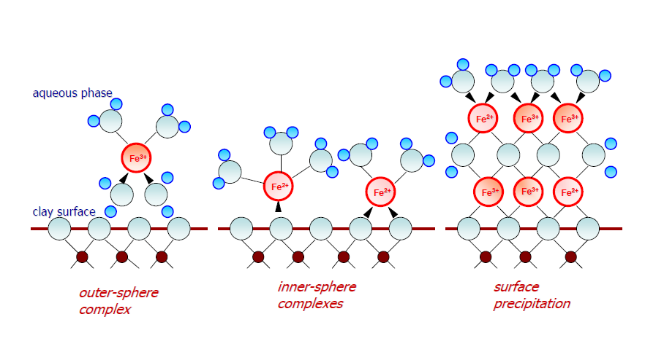
 Leaks of acid mine waters in the Kutná Hora district (high concentrations of arsenic and iron)
Leaks of acid mine waters in the Kutná Hora district (high concentrations of arsenic and iron)






